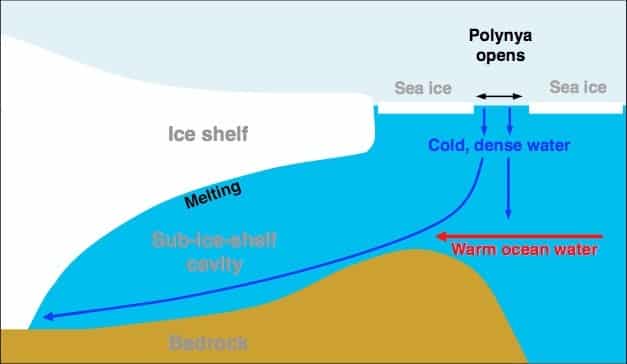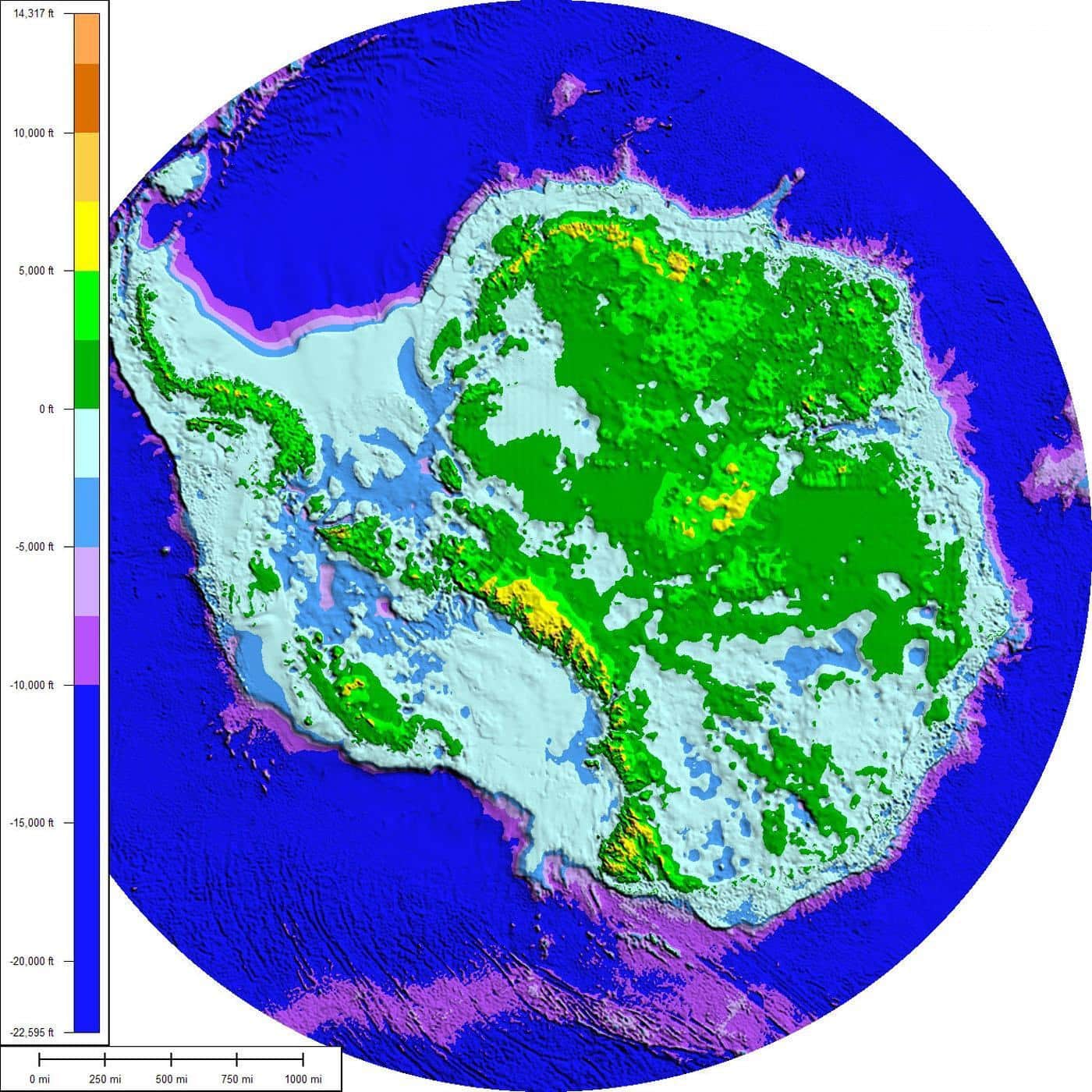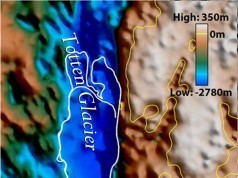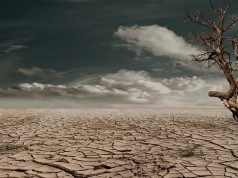A curious fact has baffled those who observe Earth: the Antarctic sea ice has been augmenting, year after year (whereas it has been shrinking year after year around the North Pole, as expected). How could the former fact, increasing sea ice, be compatible with global warming?
Scientists have been baffled. Some meekly suggested that stronger winds spread the cold water, and sea ice, further out. Winds have increased in the Antarctic Ocean, indeed. The latter point is straight from what one would expect of global warming: heat is motion on the smallest scale, resulting in density differentials, thus pressure differentials, hence winds, from high to low pressures.
The continent of Antarctica seems to be a solid mass, but the reality below all that ice is different. If one melted all the ice, Antarctica, at this point is more like an archipelago.
(However, if the ice melted, the continent would raise by hundreds of meters… I would guess, taking into account that rock is about three times the density of ice. But that would take millennia. Many quakes, as still experienced in Scandinavia, which is still rising at the pace of one meter per century.)
Notice that it is often much deeper inland than along the continental margins. The West Antarctic Ice Shield (WAIS; drained by the Pine, and other glaciers mentioned below) is on the left. To the bottom of the page, one sees the Wilkes Subglacial Basin I mentioned in 2009. Right of it is the Totten catchment and Aurora Subglacial basin.
Most of these three giant basins have up to 4 kilometers of ice any of these If the three of them melted, sea level would go back to conditions 5 million years ago (when CO2 levels were the same as today). The ocean would be up to 40 meters higher.
I will suggest a much more sinister explanation for the spreading of the sea ice around Antarctica (sinister explanations are my specialty).
The warm water comes from below, dragged by current, and its higher density (caused both by its salt content, and the fact warmer water is denser, close to the freezing point, a weird fact of H2O). When it rubs along the ice shelf, it gets colder, hence less dense, all the more as it mixes with glacial sweet (thus less dense) water.
Thus, the more extended the sea ice is around Antarctica, at this point, the greater the evidence that the ice continent is losing cold, so to speak: it loses cold by spreading out at the surface of the ocean.
Something similar, on a much larger scale, caused a massive cooling of Europe 18,000 years ago (so-called Younger Dryas). Right in the middle of global warming, Europe froze for a millennium (due to the spread of cold water from Greenland melting, plus the subsequent short-cut of the Gulf Stream).
Here is a related fact. My friend Paul Handover called my attention on the following opinion I used to have:
“The melting of the ice sheet over Greenland is now a given. The ice sheets of West and East Antarctica a hair’s breadth from being a given.”
This is what I thought, say ten years ago. However I do not believe this opinion anymore: Antarctica will melt before Greenland. And nobody expects this.
Reason: it is easier to melt ice with warm water than with warm air, because the caloric capacity of water is much higher. Much of Antarctica, East and West is below sea level.
All the continental margin of Greenland is mountainous, and extends for hundreds of kilometers (mostly, although very long deep canyon have been found, lurking below the ice, in the last couple of years). In the case of Antarctica, the mountainous margins are either perfunctory and thin (WAIS), or inexistent (East Antarctica). This is why what was supposed to melt last, big time, East Antarctica may well melt first, big time.
Another factor, also overlooked, is that a lot of Antarctica’s coast is at pretty high latitude (hugging the polar circle), especially in East Antarctica, whereas only the mountainous tip of Greenland is south of the polar circle.
Here is the Geophysical Research Letters on 27 May 2014 about the catastrophic situation in West Antarctica: Widespread, rapid grounding line retreat of Pine Island, Thwaites, Smith, and Kohler glaciers, West Antarctica, from 1992 to 2011.
The grounding line retreat of glaciers draining the Amundsen Sea sector of West Antarctica was documented, using Earth Remote Sensing from European satellites (which went many times over their lifespans).
(ERS-1/2) satellite radar interferometry from 1992 to 2011 showed the following:
Pine Island Glacier retreated 31 km at its center, with most of the retreat in 2005–2009 when the glacier ungrounded from its ice plain. Thwaites Glacier retreated 14 km along its fast flow core and 1 to 9 km along the sides. Haynes Glacier retreated 10 km along its flanks. Smith/Kohler glaciers retreated the most, 35 km along its ice plain, and its ice shelf pinning points are vanishing. These rapid retreats proceed along regions of retrograde bed elevation (this means that, the further inland, the lower the ice plain below the glaciers; so warm water has a potential to fall DOWN towards the INTERIOR of the continent, as the future sea floor is crushed by the mass of the ice).
The team concluded: “Upstream of the 2011 grounding line positions, we find no major bed obstacle that would prevent the glaciers from further retreat and draw down the entire basin.”
A similar situation holds under the Ronnie Ice Shelf, east of the base of the Antarctica Peninsula. There again the Ice Shield rests mightily on an old ocean floor, sloping down towards the interior, to a depth of at least a mile. I don’t see why this sort of contraption cannot melt, and disintegrate, in a few years. I really don’t. Actually, I fully expect it. I don’t see how it could be otherwise.
This is the ultimate sucking sound… And something nobody very seriously employed as a “climate scientist” can afford to believe, lest she/he, wants to go live under a bridge.
Lest some will conclude that this is just a matter of a few billion people moving out of the way, please be reminded that the littoral is often where the best lands are.
But not just this. The assault of humanity against the biosphere are many, and some of these attacks are directed at the CO2 absorbing system. For example the Amazon absorbs only half the CO2 that it did, twenty years ago.
We need much more advanced technology, just to save the biosphere. Now.
Patrice Ayme’








